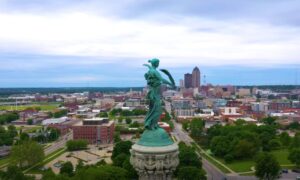Des Moines, the capital and most populous city of Iowa plays a central role in the state’s political, economic, and cultural landscape.
Known for its significance in U.S. politics due to its role in the Iowa caucuses, Des Moines also serves as a business hub, housing major corporations and insurance companies.
As of 2024, Des Moines continues to be a focal point for both urban and suburban developments, providing insight into broader population trends in Iowa.
Des Moines Population Data in 2024
Des Moines population is estimated to be 209,232, according to WorldPopulationReview. It reflects a continuing trend of population decline within the city proper, with an annual reduction rate of approximately -0.55% since 2020.
Despite this decline, Des Moines remains Iowa’s largest city, retaining its political, economic, and cultural significance.
Various factors have contributed to this reduction in population, including:
- Suburbanization: Many residents, particularly families, are choosing to move to the suburbs where larger, more affordable homes and better amenities are available.
- Economic Shifts: Certain industries within the city have either stagnated or relocated, impacting job availability and income opportunities for residents.
- Housing Affordability: Rising housing costs and a lack of new developments within Des Moines have made it difficult for many to find suitable and affordable homes in the city.
- Consequently, people are opting for more affordable living arrangements outside the city limits.
Metropolitan Area
The Des Moines metropolitan area, which includes surrounding suburbs and exurban areas, has witnessed substantial growth.
The metro population in 2024 is estimated to be 573,000, marking a 1.24% increase from the previous year, as MacroTrends writes. It is driven by several factors:
- Expanding Job Markets: Many businesses and industries, especially in sectors such as insurance, finance, and healthcare, continue to grow in the suburban areas, providing ample job opportunities for new residents.
- Affordable Housing Options: Unlike the urban core, the suburbs and exurbs surrounding Des Moines offer affordable housing choices.
- Quality of Life: The suburbs provide access to better schools, green spaces, and a lower cost of living, which are particularly attractive for families looking to settle down in a less congested environment.
The contrasting trends between Des Moines proper and the broader metro area reflect a broader national shift toward suburban living, where many people are seeking a balance between affordability, quality of life, and proximity to urban centers.
What needs to be said is that both urban and metro areas can provide numerous interesting activities for first-time visitors.
What About Demographics?
Des Moines continues to exhibit a diverse racial and cultural composition, shaped by decades of migration and the city’s role as a welcoming community for people from various backgrounds.
According to Neilsberg, the racial demographics of Des Moines reflect diversity:
| Race | Percentage (%) |
|---|---|
| White | 69.91% |
| Black or African American | 11.75% |
| Two or More Races | 7.38% |
| Asian | 6.61% |
| Other Races | 4.01% |
This broad racial mix not only highlights the city’s past as a cultural crossroads but also positions Des Moines as a hub for growth in the future, as it continues to attract new residents from across the country and internationally.
Age Distribution
As DataUsa points out, the median age among the Des Moines population is 34.4 years, indicating a relatively young population that contributes actively to the local economy and workforce. Des Moines’ age distribution reveals a balanced mix of different generations:
- Young Professionals and Families: Many young professionals and families continue to reside within the city limits, contributing to its vibrant economy.
- Suburban Shift: An increasing number of residents, especially those with families, are relocating to the suburbs, drawn by affordable housing and larger living spaces.
Here is a breakdown of Des Moines’ age structure:
| Age Group | Percentage (%) |
|---|---|
| Under 18 | 23.4% |
| 18-34 | 29.6% |
| 35-54 | 24.2% |
| 55 and older | 22.8% |
Linguistic Diversity
In terms of language, the linguistic landscape of Des Moines reflects its diverse population. The majority of residents speak English as their primary language, but there is a growing number of residents who speak other languages, particularly Spanish:
- English-only speakers: 79.47%
- Spanish speakers: 10.17%
- Other languages: 10.36%
The increasing presence of Spanish and other languages in Des Moines reflects the city’s role as a destination for immigrants, usually from Latin American countries like Mexico.
Socioeconomic Indicators
Des Moines’ socioeconomic landscape offers a mix of both promising opportunities and pressing challenges.
Below is an overview of the key indicators shaping the city’s economic and social fabric.
| Indicator | 2024 Figure | National Average |
|---|---|---|
| Average Household Income | $79,959 | $70,784 |
| Poverty Rate | 15.2% | 11.4% |
| Unemployment Rate | 3.3% | 5.3% |
| Percentage with Bachelor’s Degree | 19.69% | 20.5% |
| Percentage with Associate Degree | 9.41% | 8.5% |
Average Household Income
In 2024, the average household income in Des Moines is $79,959, slightly higher than the state average, as Point2homes shows.
It reflects the presence of a relatively well-compensated workforce in sectors like finance, insurance, and healthcare. However, there is a significant wealth gap among residents.
Poverty Rate
Despite the above-average income levels, the city faces a poverty rate of 15.2%. This highlights economic disparity, with some residents facing difficulties due to factors such as:
- The rising cost of living
- Wage stagnation in certain industries, particularly retail and service sectors
- A shortage of affordable housing for low-income families
Unemployment Rate
The city’s unemployment rate is currently 3.3%, which is lower than the national average, signaling a generally healthy job market. Key industries that contribute to employment include:
- Insurance
- Financial services
- Healthcare
However, some industries, such as retail and hospitality, continue to face challenges, resulting in income disparities and employment instability for workers in these sectors.
Educational Attainment
Educational attainment in Des Moines shows a relatively educated population, but still highlights areas for improvement in comparison to other U.S. metro areas:
- Bachelor’s Degree Holders: 19.69% of residents hold a bachelor’s degree, which is slightly below the national average.
- Associate Degree Holders: 9.41% of the population has an associate degree, reflecting the presence of a skilled workforce in technical and mid-level professions.
Historical Population Trends
Des Moines’ population trends have shown significant fluctuation over the decades, particularly between the city and the broader metro area. In 1950, the Des Moines metro area had a population of just over 201,000.
| Year | Metro Population | City Population | Annual Growth Rate (%) |
|---|---|---|---|
| 1950 | 201,000 | Not available | 1.0%-2.0% |
| 1980 | 360,000 | 191,003 | 1.5%-2.0% |
| 2000 | 480,000 | 200,000 | 1.2%-1.5% |
| 2024 | 573,000 | 209,232 | 1.24%-1.49% (Metro) |
Over the ensuing decades, the metro area experienced consistent growth, driven by several key factors:
- Economic Expansion: The metro area benefited from growing industries, particularly insurance and finance, which attracted new residents and increased job opportunities.
- Urbanization: Early growth in Des Moines was fueled by urbanization, as the city developed its infrastructure and amenities, drawing more people into the metro area.
- Suburbanization: Starting in the latter half of the 20th century, suburbanization began to take hold, with many residents seeking more space, affordable housing, and improved quality of life outside the urban core.
Suburban Growth and Urban Decline
- 1980s-2000s Suburban Boom: During this period, suburban areas expanded significantly as young families and professionals moved out of the city in search of larger homes, better schools, and a quieter lifestyle. This suburban expansion saw the metro area grow rapidly, while the city itself faced slower growth.
- Industry Attraction: The growth of industries like insurance and financial services during these decades attracted new businesses and residents, boosting the economy and solidifying Des Moines’ status as a financial hub in the Midwest.
Methodology
The data collection methodology for Des Moines’ population and socioeconomic trends in 2024 is based on a combination of authoritative sources such as WorldPopulationReview, MacroTrends, and DataUsa, all of which compile demographic statistics using:
- Census records
- Public datasets
- Projection models
Population estimates are often derived from the latest U.S. Census Bureau data, alongside yearly surveys like the American Community Survey (ACS), which helps track migration, age distribution, and socioeconomic factors.
These sources use a combination of historical data trends and statistical models to provide projections for future population changes in both the city and metro area.
The data regarding economic indicators, including average household income, unemployment rate, and poverty levels, is sourced from platforms such as Point2Homes and Neilsberg, which compile national and local economic data from the Bureau of Labor Statistics and other governmental resources.
The educational attainment and language statistics are based on detailed surveys conducted by the Census Bureau and supplemented by localized data collection through community surveys.
Together, these methodologies ensure a comprehensive and up-to-date understanding of Des Moines’ population dynamics for the year 2024.
The Bottom Line
Des Moines’ population trends in 2024 highlight a tale of two growth trajectories: a declining urban core and a thriving metro area.
While the city itself faces challenges in stemming population decline, the surrounding metro region continues to expand.
Understanding these dynamics is key to addressing future growth and development in both Des Moines and its suburbs.















